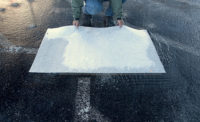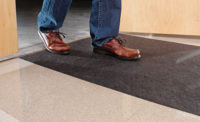Rain, snow and mud don’t just look bad when they get tracked into the building. They can be dangerous. Grabbing a “Wet Floor” sign from the custodian’s closet probably isn’t enough to prevent slip and fall injuries in entranceways.
Contaminants on the floor cause more than half of all slip and fall injuries. In entrances, contaminants can be rain, snow, slush, mud, dirt or grass clippings that get dragged in on people’s feet. Contaminants can also come in the form of food or beverage drips and spills. Anything that comes between a walking surface and someone’s foot is a contaminant that could lead to a slip and fall injury.
It can be nearly impossible to prevent these contaminants from entering buildings. Planning and establishing a housekeeping program to address them minimizes the chance for injuries.
Begin outside
According to the Worldwide Cleaning Industry Association, (ISSA) about 80 percent of the dirt in a building is tracked in on peoples’ feet. The earlier it is trapped, the less expensive and time consuming it is to remove it from other parts of the building. Trapping it early also reduces risk.
Spend some time outside observing how people get to building entrances. Do they use sidewalks, or do they walk through unpaved areas? When people walk through unpaved areas before entering a building; more dirt, water and grass clippings will enter the building.
Critique drainage around the building. Roof drains that channel water onto sidewalks or near entrances increase the amount of water entering the building. They can also create ice patches in the winter. Drain outlets near landscaped areas can also cause mulch, pebbles or other landscaping cover materials to wash onto walking surfaces.
Landscaping makes entrances more appealing – but it can also contribute to dirt, water and other slippery contaminants entering the building. Bushes that shed flowers or berries onto sidewalks, trees and bushes that shed leaves, and grass clippings that aren’t collected can all be slippery – especially when they’re dragged from a rough concrete sidewalk onto a smooth-floored lobby.
Prepare for stormy weather
An important strategy for preventing slips and falls in entrance areas is to keep as much of the outdoors as possible from getting indoors. When it’s dry, this includes having a plan for regularly sweeping sidewalks and walkways to prevent dirt from being tracked in. It may also include having low-profile outdoor scraper mats in front of each entrance.
In areas that see a lot of snow or rain, plans may include having awnings or canopies near entrances to keep paths clear directly in front of the building. Awnings and canopies give people the opportunity to shed water or snow from their jackets, umbrellas and feet before entering the building.
For snow, plans should include timetables for removing snow and ice from sidewalks and parking lots so that they are clear before employees or customers arrive.
Interior considerations
Entrances make a lasting first impression. Care is taken to choose everything from pictures and window dressings to doorknobs and floor coverings. When those floor coverings are smooth and shiny, they may look fantastic – but they often contribute to slips and falls when they’re wet.
While it’s not necessary to completely redesign building entrances, having a plan that addresses how entrance areas will be kept dry and clean will help to ensure that whatever residual contaminants do get tracked into the building won’t get very far before they are contained.
For many organizations, entrance matting is used to collect water, snow and dirt from people’s feet as they enter.
When choosing entrance matting, select mats that are absorbent or ones that have bi-level construction to allow dirt and water to collect below the top walking surface. Mats that are not absorbent should also have barriers around their edges to capture water so that it doesn’t drain off as the mat as the mat becomes saturated. Water that pools around the edges of mats creates a slip hazard as people step off the mat. If the mat is not adhesive backed, water can also creep under the mat, allowing the mat to slip when someone steps onto it.
Watch people as they enter to determine the amount of entrance matting that is needed. When people step off the matting, their feet should be dry. People usually need to take about five to six steps to remove water from their feet, but weather and traffic volume both figure into how much matting is needed in any given entrance. When choosing mats, it’s better to use longer mats instead of putting multiple smaller mats end-to-end.
Clean floors correctly
Whether the floor is marble, granite, vinyl, tile, wood or concrete; it needs to be properly cleaned to remain slip resistant. That doesn’t mean that it needs to be professionally cleaned every day, but it does mean that it needs to be cleaned correctly. Improper cleaning can allow dirt to build up on the floor’s surface. It can also ruin protective and non-slip finishes or coatings.
Choose cleaning chemicals that are specifically formulated for the type of flooring where they will be used. No matter what type of flooring is present, it should ideally be cleaned and have time to dry before people walk on it.
Housekeeping programs
The plans that have been developed to prevent contaminants from entering the building as well as the plans for maintaining entrances can both be rolled into housekeeping programs to help ensure ongoing slip and fall prevention in and around entrances.
Thinking that “someone” will take care of an indoor or outdoor concern often leads to no one performing the task. Assign responsibilities for any necessary item in the plan, from clearing snow and removing wet leaves from walkways to putting out the umbrella stand, getting the wet floor signs out of the closet and turning on the floor drying fan. Assignments also need to include removing signs and floor dryers when the floor is no longer wet.
When it comes to floor safety planning, entrances can be overlooked because people typically don’t spend a lot of time there. But they are frequently used, and because they often require people to step from a high traction outdoor surface to a lower traction indoor surface, they are a common location for slip and fall injuries. Identifying hazards and developing a program to keep these areas slip-free will reduce the chance for injuries.









